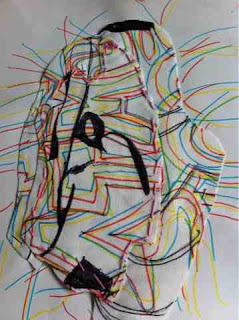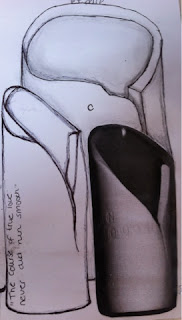While visiting Athens I was inspired by the bold, dynamic graffiti that was plastered all over the walls. This inspired me because it was so unique and quirky and the graffiti looked like art work. As I found the graffiti so inspiring I decided to create a project that would incorporate fashion and graffiti. The idea of this works well because it is controversial and uncommon. Fashion design is not my area as I'm not interested in sewing so I decided to create illustrations because I have strong observation skills
In this project I have used a number of different formal elements. I have used line to show the flow of movement with in my illustrations. I created this element using a biro pen because it highlights shapes and gives the illustrations free form. Another formal element I have used is colour. I used colour to create dynamic, loud illustrations so they are vibrant and exciting. I used watercolours to show this element because not only can you get bold colour but you can create tone usin this material. Using watercolour shows the contrast between light and shadow giving the illustrations a 3 dimensional depth. The main element I have used is composition. Using composition helped me to place different areas of the illustration which helped with my decision making. The composition of my illustrations were unbalanced so one side was heavier than the other. With the heavier side being dominant we are drawn to that area.
Through out this project I think my strengths has been my artist research. As I looked at a variety of different fashion illustrators I hade a wide range to experiment with. This helped with my decision making and the choice of the materials I was going to use. When first creating my final illustrations A problem occurred where they were too flat and busy. I overcame this problem by taking back a few steps and looking at my research. By doing that I rethought about the composition and the components going to be used. After doing that I came up with successful, crisp outcomes.
My strength here was my detirmination as I wanted to have a successful show. Even though I have annotated everything I think this area is the biggest weakness because I don't believe that I have annotated it thoroughly enough. From this I have learnt that annotation is equally important as the practical work so in future I am going to spend more time on the theoretical side. Setting up the exhibition and preparing for it went well because I had my illustrations create and printed in time so I had my work up quickly.
From this project I have learnt that artist research is extremely important because it is the grounding of your projects and inspires your ideas. I have also learnt that experimenting with a wide variety of materials is helpful because you have a wide range of choice to develop from. While creating my illustrations my MAC based skills have improved a lot because I now know a broad range of techniques that I can use in the future. Another skill I have learnt is how to set up an exhibition. I believe that this went well because everyone worked as a team and had eachothers opinions to develop from.
Overall I think my project has gone well because I have a strong body of research and development. I think it has gone well because I have problem solved to create successful and professional outcomes. I believe that my exhibition display was successful because it shows a development process on the boards so the public can understand where I got my ideas from. If I was going to do this project again I would think more into the model layer of my piece and play around with poses so I could have a more unique outcome. I would also use more pattern to create texture and give it depth. To develop from what I have produced I would play around with brighter colour palettes, textured patterns and compositions. I am pleased with what I have produced for my FMP because Inhave kept developing further throughout this project. Even though I am happy with my exhibition and outcomes I would like to push my illustrations further because I believe they can be experimented with more.



















































